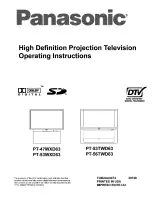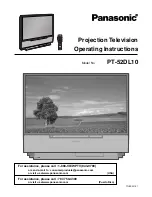
Operating Tips
The perforations
in the film should be
toward you as film comes off the bottom
of the supply reel. If they are not, the
film has not been rewound orwas
twisted while being rewound.
• If the gate is left open, the projected
picture will be out of focus.
• If the picture is unsteady, check the
upper and lower loops; these must be
maintained.
The lower loop should not
touch the master control cover or the
loop-forming
roller. The sprocket teeth
must show through the film perfora-
tions. Make sure that the gate and the
sprocket clamps are closed.
• If loss of lower loop occurs:
threaded
for sound
or
silent pictures, page 6-
quickly press down the loop-forming
roller as far as it will go while the pro-
jector is running and then release the
roller;
threaded for silent projection,
alternate method, page
8-stop
the
motor immediately
and re-form the
loops.
• If the projector is stopped during the
projecting
of a reel of sound film, turn
the thread knob several revolutions
clockwise to take up any slack between
the lower sprocket and the sound drum.
• If there is no sound,
be
certain that:
Speaker cord is connected.
The fuse is not blown.
Sound track is overriding
edge of
sound drum properly and film is be-
tween the flanges of sound drum
pressure roller.
Exciter lamp is not burned out and is
seated on all three studs.
Sound-input
switch is set at proper
position.
• If the sound quality is not up to par,
be
certain that:
Speed selector is at proper position.
Film is snug around sound drum and
drum is clean.
Volume is not too high and tone control
is correctly adjusted.
Sound focus lever is adjusted for
correct sound optics focus.
Film sound track is of good quality and
clean.
Sound optics unit has been properly
seated after cleaning.
12
Screen • Lamp •
Lens Combinations
Proper selection of screen, lamp, and
lens for your particular
setup is
important.
The screen image should
be of adequate size and brilliance for
comfortable
viewing. With the wide
variety of lenses available for your
PAGEANT
Projector, you can tailoryour
equipment
to meet this requirement.
The chart shows the relation between
projection
distances and screen sizes
for each of the currently
available
lenses. It is best to use a lens that
provides a screen image of a height
that is not less than one-eighth of the
distance from the screen to the back
row of seats. If the image is smaller
than this, the viewers in the back rows
will not be able to see the fine detail
in the pictures.
Make sure that the screen image is
neither too bright nor too dark. If it is
too bright, flicker may become objec-
tionable;
if too dark, detail will be lost
in the shadow areas of the pictures.
Shown in the table are the maximum
image widths or heights for adequate
illumination
on matte screens and on
lenticular
or beaded screens with the
lamp set on HI. These maximum widths
or heights are for good projection
conditions
in a darkened room; they
will have to be somewhat less if there is
much stray light in the room.






































